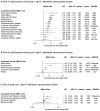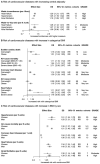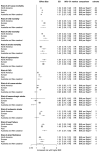Association between adiposity and cardiovascular outcomes: an umbrella review and meta-analysis of observational and Mendelian randomization studies
- PMID: 34333589
- PMCID: PMC8423481
- DOI: 10.1093/eurheartj/ehab454
Association between adiposity and cardiovascular outcomes: an umbrella review and meta-analysis of observational and Mendelian randomization studies
Abstract
Aims: The aim of this study was to investigate the causal relationship and evidence of an association between increased adiposity and the risk of incident cardiovascular disease (CVD) events or mortality.
Methods and results: Observational (informing association) and Mendelian randomization (MR) (informing causality) studies were assessed to gather mutually complementary insights and elucidate perplexing epidemiological relationships. Systematic reviews and meta-analyses of observational and MR studies that were published until January 2021 and evaluated the association between obesity-related indices and CVD risk were searched. Twelve systematic reviews with 53 meta-analyses results (including over 501 cohort studies) and 12 MR studies were included in the analysis. A body mass index (BMI) increase was associated with higher risks of coronary heart disease, heart failure, atrial fibrillation, all-cause stroke, haemorrhagic stroke, ischaemic stroke, hypertension, aortic valve stenosis, pulmonary embolism, and venous thrombo-embolism. The MR study results demonstrated a causal effect of obesity on all indices but stroke. The CVD risk increase for every 5 kg/m2 increase in BMI varied from 10% [relative risk (RR) 1.10; 95% confidence interval (CI) 1.01-1.21; certainty of evidence, low] for haemorrhagic stroke to 49% (RR 1.49; 95% CI 1.40-1.60; certainty of evidence, high) for hypertension. The all-cause and CVD-specific mortality risks increased with adiposity in cohorts, but the MR studies demonstrated no causal effect of adiposity on all-cause mortality.
Conclusion: High adiposity is associated with increased CVD risk despite divergent evidence gradients. Adiposity was a causal risk factor for CVD except all-cause mortality and stroke. Half (49%; 26/53) of the associations were supported by high-level evidence. The associations were consistent between sexes and across global regions. This study provides guidance on how to integrate evidence from observational (association) and genetics-driven (causation) studies accumulated to date, to enable a more reliable interpretation of epidemiological relationships.
Keywords: Cardiovascular disease; Coronary heart disease; Mendelian randomization study; Meta-analysis; Stroke; Umbrella review.
© The Author(s) 2021. Published by Oxford University Press on behalf of the European Society of Cardiology.
Figures






Comment in
-
Obesity and cardiovascular health: the size of the problem.Eur Heart J. 2021 Sep 7;42(34):3404-3406. doi: 10.1093/eurheartj/ehab518. Eur Heart J. 2021. PMID: 34379742 Free PMC article. No abstract available.
References
-
- Wang G, Zheng Z-J, Heath G, Macera C, Pratt M, Buchner D.. Economic burden of cardiovascular disease associated with excess body weight in US adults. Am J Prev Med 2002;23:1–6. - PubMed
-
- Emamgholipour S, Sari AA, Pakdaman M, Geravandi S.. Economic burden of cardiovascular disease in the southwest of Iran. Int Cardiovasc Res J 2018;12:6–12.
-
- Gaziano TA.Economic burden and the cost-effectiveness of treatment of cardiovascular diseases in Africa. Heart 2008;94:140–144. - PubMed

